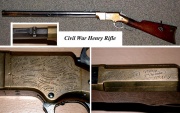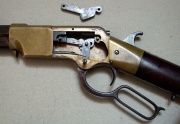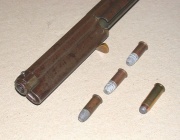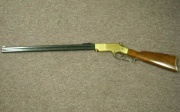Henry rifle
| Henry Repeating Rifle | |
|---|---|
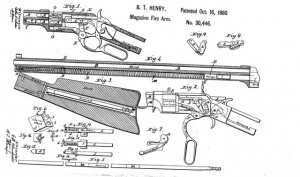
| |
| Original patent drawing of the Henry rifle | |
|
| |
| Type | lever-action rifle |
| Land of Origin | USA (Union) |
| Specifications | |
| Cartridge | .44 caliber rimfire |
| Action | Lever Action, breech-loading |
|
| |
| Rate of Fire | up to 28 rounds/min. |
| Feed | 16 round tube magazine |
| Service History | |
| Used by | limited usage by both Union and Confederate forces |
| Wars | American Civil War, Indian Wars |
| Production History | |
| Designer | Benjamin Tyler Henry |
| Design Date | 1850s |
| Manufacturer | New Haven Arms Company |
| Unit Cost | US$14-16,000 (see text) |
| Produced | 1858-1866 |
| No. Built | ~14,000 |
Contents |
[edit] History
The original Henry repeating rifle was an American .44 caliber rimfire, lever-action, breech-loading rifle designed by Benjamin Tyler Henry in the late 1850s. The Henry rifle was an improved version of the earlier Volcanic Repeating rifle. The Henry rifle used copper (later brass) rimfire cartridges containing 25 grains (1.6 g) of gunpowder to a 216 grain (14 g) bullet. 900 Henry rifles were manufactured between summer and October 1862; by 1864, production had peaked at 290 per month. By the time production ended in 1866, approximately 14,000 units had been manufactured.
The rifle's original list price was $42; as of 2004, an original 1862 Henry rifle may bring $14,000 (one sold in November 2006 for $60,000) in the collectors' market. For a civil war soldier, owning a Henry rifle was a point of pride. Although it was never officially adopted for service by the army, many union soldiers purchased Henry rifles with their own funds. The brass framed carbines could fire at a rate of 28 rounds per minute when used correctly, so soldiers who saved their pay to buy one often believed that the rifle would help them survive. They were frequently used by scouts, skirmishers, flank guards, and raiding parties, rather than in regular infantry formations. To the amazed muzzleloader-armed Confederates who had to face this deadly "sixteen shooter," it was "that damned Yankee rifle that they load on Sunday and shoot all week!"Very few captured Henry rifles were used on a limited basis by Confederate troops. Since those few Confederate troops who came into possession of one of these rifles had little way to resupply the special ammunition used by this gun, its widespread use by Confederate forces was very impractical. The rifle was however, known to have been used at least in part by some fifteen different Confederate units. These units included cavalry units in Louisiana, Texas, and Virginia, as well as the personal bodyguards of Confederate President Jefferson Davis.[1]
Manufactured by the New Haven Arms Company, the Henry rifle would soon evolve into the famous Winchester Model 1866 lever-action rifle. With the introduction of the new Model 1866, the New Haven Arms Company would be renamed the Winchester Repeating Arms Company.[edit] Mechanical Workings
The Henry rifle used a .44 caliber cartridge with 26 or 28 grains (1.8 g) of black powder.[2] This gave it significantly less muzzle velocity and stopping power than comparable repeaters of the same era, such as the Spencer repeating rifle. The lever action, on the downstroke, ejected the spent cartridge from the chamber and cocked the hammer. A spring in the magazine forced the next round into the chamber and locking the lever back into position sealed the rifle back up into firing position. As it was designed, the rifle was not a very safe weapon. A Henry rifle, when not in use, would either have the hammer cocked or resting on the firing pin of the cartridge. In the first case, the rifle has no safety and is in firing position. In the second, an impact on the back of the exposed hammer could cause a chambered round to fire.[edit] Current production
In 1973, Louis Imperato bought the firearms company of Iver Johnson and began making commercial versions of the M1 carbine. In 1993, Imperato started a factory in his native Brooklyn to manufacture .22 caliber rifles under the newly recreated name[3] of the Henry Repeating Arms Co. which are currently manufactured in Brooklyn, New York. (The current company, Henry rifles[4], does not produce the Civil War period firearm that this article defines. It produces lever action rifles that are more akin to later Marlin types.)
A. Uberti Firearms produces an almost exact copy Henry Model 1860, although it is not available in .44 Henry Rimfire. Instead, they are chambered for centerfire calibers such as .44-40 Winchester and .45 Long Colt. These replicas are distributed through Navy Arms Company.[5] The guns are popular among Civil War reenactors, as well as competition shooters in the North-South Skirmish Association (N-SSA).[6]
[edit] Media appearances
- In many other Western movies and TV shows, you will often see other model Winchesters, usually Model 92s, but occasionally '73s and '94s, with the forestock removed and referred to as "Henry" rifles. These guns are usually referred to by firearms enthusiasts as "Hollywood Henrys". Such a rifle can be seen used by Gregory Peck in the film The Stalking Moon. In some closeups during the film, the Winchester loading gate can clearly be seen, which was not present in a Henry rifle.
[edit] See also
[edit] References
- ↑ http://www.rarewinchesters.com/articles/art_hen_07.shtml
- ↑ The Henry Repeating Rifle, Introduction
- ↑ American Rifleman
- ↑ American Rifleman
- ↑ http://www.navyarms.com/html/henry_rifles-carbs.html
- ↑ NSSA Approved Arms page.
- Hartford Michigan Military History
- American Rifleman, May 2008; (Henry Repeating Arms) founder, p. 26
- Sword, Wiley. The Historic Henry Rifle: Oliver Winchester's Famous Civil War Repeater. Lincoln, Rhode Island : Andrew Mowbray Publishers, 2002.
- Compared: .357 Mag. Henry Big Boy, Marlin 1894C and Uberti 1873 Rifles by Chuck Hawks
[edit] External links
- Henry rifle at the Texas Gun Collectors Association website
- Renowned Henry Rifle expert Leroy Merz
- Advertisement and Henry rifle at Winchester Mistery House
- More about the patent
- Henry Repeating Arms Company Website of the modern Henry Repeating Arms Company
- Website of A. Uberti Firearms
- Henry repeating rifle US Patent no. 30,446 & other resources

This article has no links to any manuals whatsoever! This article needs more input to fill in those missing bits. You (yes, you!) can help Gunsopedia provide more comprehensive information to our users by submitting a manual that you might have. See this page to find out how you can contribute a manual to the Gun Owners' Resource Online Library and help your fellow gun owners. With your help, we really can make this a one-stop resource for all gun owners!
